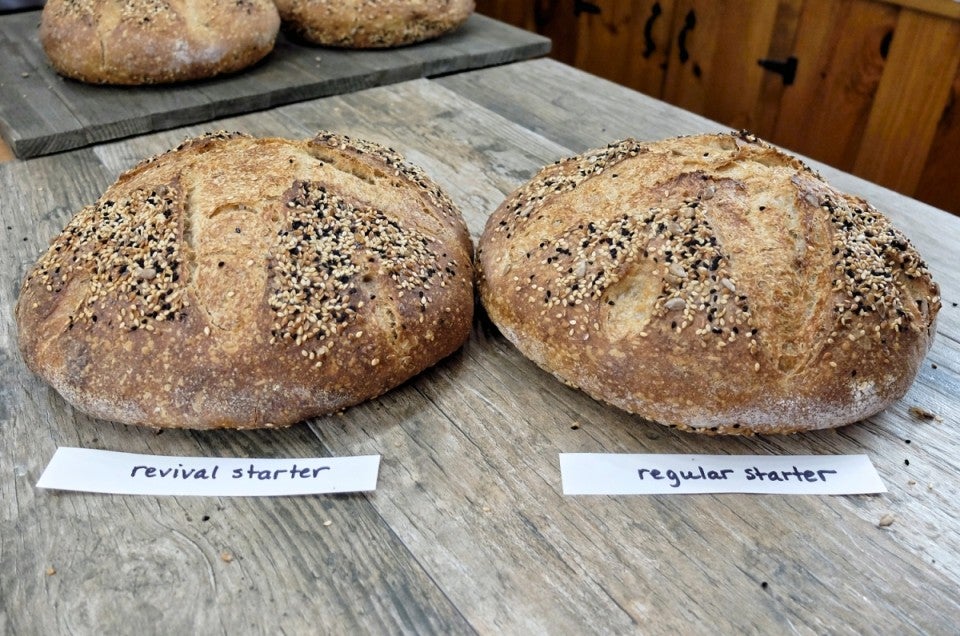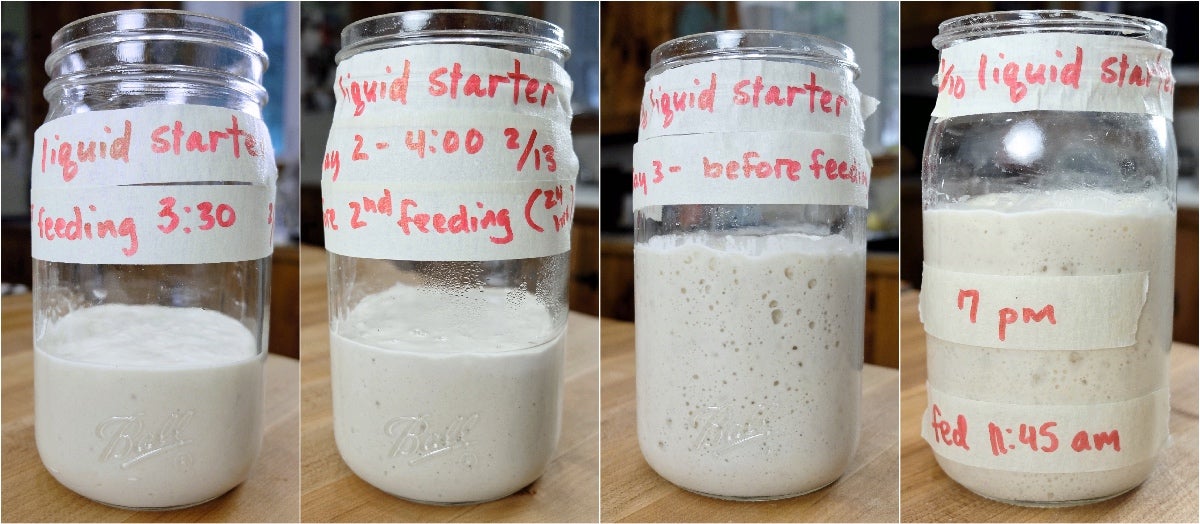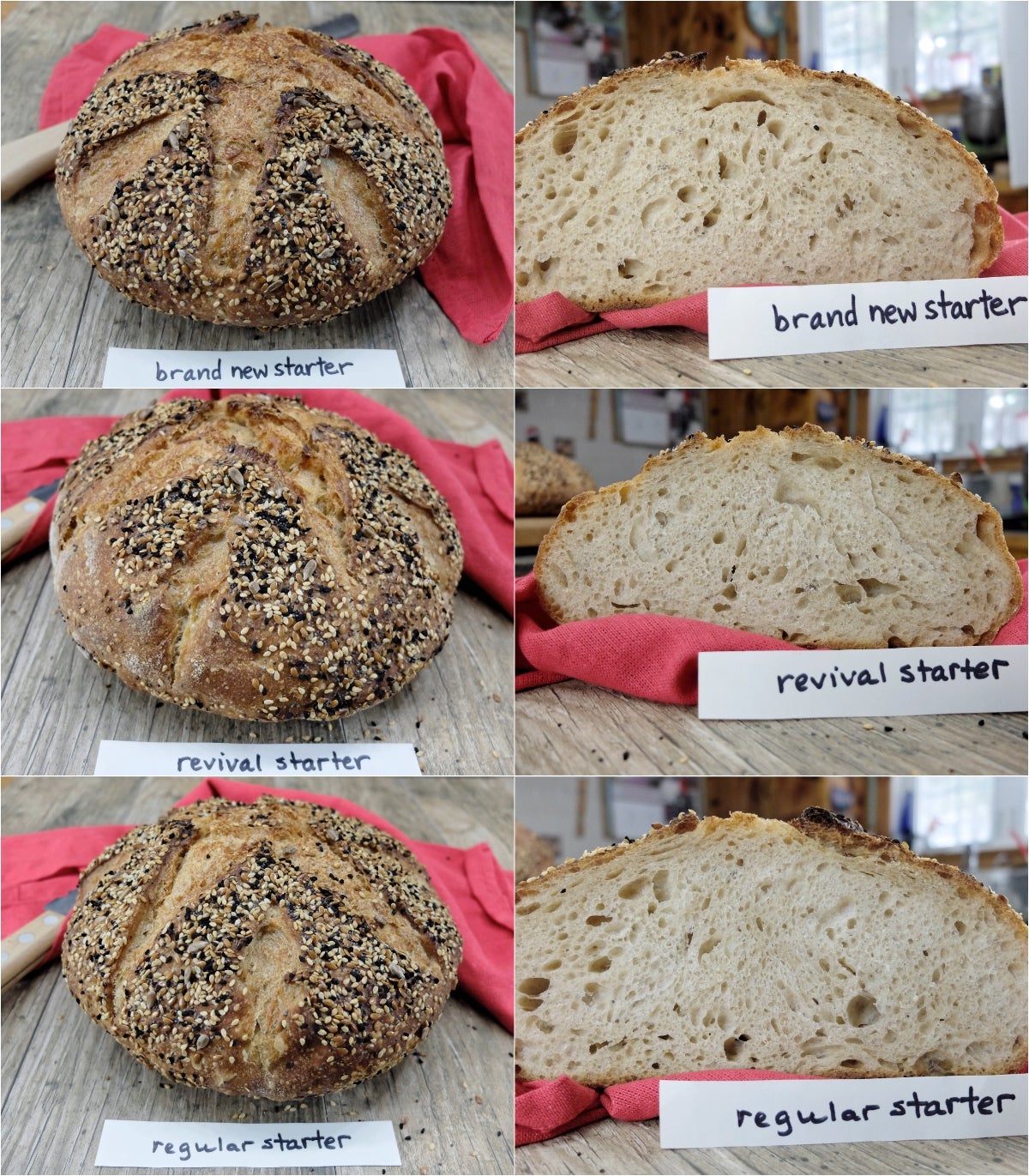


In our first sourdough starter troubleshooting post we tackled sourdough starter viability, and what will and won't cause your starter's demise. We also found out what a spoiled starter looks like, and how to know when it's time to throw it out and start over.
Today we'll take on the thorny question of whether it's worthwhile to try to revive an old but struggling starter — or if it's best to start over.
Creating your own starter from scratch is exciting and even a little magical; for details, see our step-by-step guide to creating a sourdough starter.
Simply mixing flour and water allows friendly bacteria and wild yeast to join forces and establish a balanced ecosystem that is able to impart great flavor and rise to your sourdough baking.

During the 6 to 10 days that it takes to get your starter up and running, it's a little more vulnerable to bacterial intruders and mold because it hasn't yet developed the defenses of a mature starter. But once fully developed, a well-maintained starter will readily fend off unwanted invaders and is very unlikely to spoil.
What if you inherited an old starter from your grandma and it's looking a little like it might be at death's door?

Sourdough authorities argue that there's nothing sacred about an old starter; a freshly developed "mature" starter will impart just as much flavor and rise to your bread.
Starting over with a new starter will get you back to baking great sourdough bread in a little over a week. So why take on the unpredictable task of trying to resurrect a sickly starter?
And is it even possible to thoroughly revive a starter that's sorely neglected?
Let's find out.


I start with two very neglected starters. Both starters (one all-purpose, one whole wheat) had been well-maintained until they were left at room temperature for a full month without being fed.
Why test both a white and a whole wheat starter? Starters can be maintained with all different types of flour, so I wanted to see if a whole wheat starter responded in the same way as a starter fed with all-purpose flour.


I pour the dark hooch off the neglected starters, and feed them following the feeding schedule called for in our sourdough starter recipe.
The revived starters smell a little "off" at first, but not awful; think vinegary sour, with a slightly unpleasant edge. Within four days they're rising well and have a nice, mildly tangy aroma. My theory is that both the acidity and the maturity of the neglected starters helps them fight off unwanted bacteria at the beginning of the process, which might allow for a faster return to a healthy and balanced starter.

By way of comparison, I also begin a starter from scratch. My brand-new starter is able to keep up in terms of rise. However, after four days it still smells a little funky and doesn't seem quite ready for baking bread.
On Day 4 (after only four feedings) I bake Naturally Leavened Sourdough Bread using my revived starters (which I mix together for the test), and my regularly well-maintained starters.


The results are a little shocking: two beautiful and delicious loaves. Both loaves taste mildly sour, although taste testers agree that the revived-starter loaf is slightly tangier.
On Day 5, after a total of six feedings, I try another test bake—this time including the brand-new starter; the revived starters, and my well-maintained regular starter.

Again, the results are surprising: three nice loaves, each with a similar rise and crumb structure. The only real difference is in the flavor of the breads. Each has mildly sour flavor, but the brand-new starter yields a slightly blander loaf.
It's definitely worth trying to revive a neglected starter (so long as it shows no signs of contamination). Pour off any discolored hooch, and start feeding it twice a day at room temperature. If it rises well and has a good aroma after three to four days, you're back in business!
We'd love to hear your own sourdough starter stories and questions below. Did you revive your starter from the brink of death? How long did it take? Is it thriving now?
For more information, please check out our first sourdough starter troubleshooting post.


August 10, 2020 at 9:52am
In reply to Thanks for your informative… by Karla (not verified)
Hi Karla, ideally you'll want to keep your starter in the 68-80 degree range, but there are certainly some strategies you can adopt to cope with your warmer temperatures. During the creation process you'll probably want to minimize refrigeration, but once your starter is established you can definitely take advantage of the refrigerator when you're not planning to bake.
First, I would recommend starting off your process with Debra Wink's Pineapple Juice Solution method. She is a microbiologist and sourdough baker who developed this starter creation process to discourage certain types of bacteria that tend to delay the wild yeast from joining the party. I like her method because it uses up very little flour in the early days when the starter isn't doing much, and it may even get you off to a quicker start.
Given your environmental temperatures you might want to create a "cool box" to keep your starter in. It doesn't have to be as cool as a refrigerator, so think picnic cooler. Check the temperature periodically and try not to let it get much higher than 80 degrees, though your starter certainly won't die if it gets in the 90's. With warmer temperatures things are likely to happen faster, so it will be important to be attentive and not let your starter sit neglected for long periods. Even in the first few days when you're meant to feed only once every 24 hours, it may be helpful to give your starter a stir half way through, to discourage mold from developing. Using cool water or juice will also be helpful in keeping the temperature of the starter in a good range, and I wouldn't recommend keeping the starter in direct sunlight, which can intensify the heat in a glass jar.
As soon as your starter begins to rise predictably (twice) with Wink's method then it's important to begin twice a day feedings and gradually (over the course of several feedings) transition to feeding with unbleached all-purpose flour. A white flour starter will be a bit easier to care for in warmer conditions, as whole grain flours tend to ferment more quickly. At this point you will also want to adjust the ratio of ingredients in your starter to accommodate your warmer conditions.
Our regular sourdough starter recipe calls for equal parts by weight of starter, water and flour (1:1:1) and twice a day feedings when the starter is maintained at room temperature. However, I suspect this won't work well for you because the starter is likely to ripen too quickly. Ideally you want to replenish (feed) your starter when it's at its highest point of rising, or just beginning to fall, which keeps yeast activity vigorous. Allowing the starter to fall significantly between feedings is likely to lead to sluggish yeast behavior. Rather than adding several feedings to your day, it can be helpful to offer your starter a relatively larger meal, which it will take longer to consume and ferment. The goal here is to line up your twice a day feedings closer to that peak of rising. For example, you could try feeding with a 1:4:4, or even 1:6:6 ratio (starter:water:flour, by weight). If you went with the quantities in our starter recipe, a 1:4:4 feeding would look like: 28g starter + 113g water + 113g flour.
Once your starter is rising (doubling) predictably with the twice a day feedings and the all-purpose flour then you can consider your starter mature and ready to bake bread. It usually takes at least 10 days for the starter to fully mature, and it may take a bit longer than that for the starter to become fully established and stable. This is the point when you can begin refrigerating your starter when you're not planning to bake with it. Just give it another feeding, let it sit out for an hour or two until it starts bubbling, and then refrigerate for about a week. We recommend feeding at least once a week, but an established starter can last much longer than that in the refrigerator.
When you want to start baking again, it will be helpful to give your starter a day or two of twice a day feedings at room temperature (or in your cooler box) to restore it's normal activity level. Again, take care to replenish your starter when it's at the peak whenever possible. If you find you're not able to feed your starter when it peaks, you can resort to sticking it in the refrigerator until you're able to feed it, which will be preferable to leaving it neglected for an extended time at warm temperatures.
I hope this helps! Let us know how it goes!
Barb
July 26, 2020 at 5:06pm
I began with the KAF sourdough starter 3 weeks ago. Used KAF whole wheat flour as instructed then switched to KAF unbleached AP flour. Have been diligent about feeding it every 12 hours, 113 g of starter, 113 g of water, 113 g of flour. I get a few bubbles, and sometimes it rises maybe 1/4". No mold or discoloration. Should I feed it more? Less? Start over?
July 28, 2020 at 9:32am
In reply to I began with the KAF… by Peggy (not verified)
Hi Peggy, well, the good news is that patience almost always pays off when it comes to creating a sourdough starter from scratch, so eventually your starter is likely to begin to double in size in a predictably fashion. There is definitely no reason to abandon ship at this point! If you don't already have your starter stored in a quart-sized wide mouth canning jar, this type of container will make it easier to see this doubling behavior when it does occur. I would also be sure that your starter is stored in a location that is somewhere in the 70-80F temperature range. While it won't kill the starter to be stored in a cooler location, this could slow down the fermentation process considerably.
While there is an alternative feeding routine you could try in order to increase the acidity of your starter (which seems to help pave the way for the wild yeast to activate), I'm always a little torn about recommending this to folks that are this far into the process, since your starter may be just on the cusp of more vigorous rising behavior. The fact that you're seeing some rising at this point indicates that the yeast is there, which is definitely a positive sign.
If you want to try the alternative feeding plan that was suggested to us by microbiologist and sourdough baker, Debra Wink, it is as follows:
1. Feed only once a day.
2. Feed with whole wheat or whole rye flour.
3. Feed with a ratio of 2 parts starter : 1 part water :1 part wholegrain flour (by weight). For example, your once a day feeding might look like: 113g starter + 57g water + 57g whole wheat flour.
Once the starter begins rising predictably (twice) it's important to resume twice a day feedings (which will further promote yeast activity). You can also gradually transition back to feeding with AP flour over the course of several feedings, and increase the ratio of water and flour to line up closer to the 1:1:1 ratio (by weight) we recommend in our sourdough starter recipe.
As far as the ratio of ingredients go, keep in mind that when you're feeding your starter twice a day at room temperature ideally you want to replenish (feed) your starter when it's at its highest point of rising, or just beginning to fall. Allowing the starter to fall significantly between feedings tends to lead to sluggish yeast behavior. Sometimes in warm conditions the starter will begin to peak very quickly and collapse long before the 12 hour mark. Rather than adding more feedings to your routine it can be helpful to reduce the portion of starter as compared to water/flour fed. Essentially you're offering your starter a relatively larger feeding, which it will take longer to consume and ferment, therby allowing you to line up your feedings closer to the peak. For example in summer months you might find you need to shift into a 1:4:4 ratio by weight, which could look like this: 28g starter + 113g water + 113g starter.
One more option to consider is reducing the size of your starter, at least until it begins to rise predictably. Any of the above scenarios can be reduced to a maintenance amount of starter that is 60-70g, which will fit nicely in an 8-ounce canning jar. For example, the alternative feeding routine might look like: 30g starter + 15g water + 15g wholegrain flour. Keep in mind that smaller starters are a little more temperature sensitive because they don't have as much padding, so fermentation is likely to happen faster when it's warm and slow down more abruptly when it's cool.
I know I've thrown a lot of ratios and information at you, so please let me know if you have further questions or concerns!
Barb
July 25, 2020 at 5:11pm
This article brought such a relief! I have not been able to feed my starter for some time and when I took it out of the fridge, it had an unusual smell. There was no pink or orange though. Thank goodness! So after a few days of feedings, it has come back to it's fabulous tasting self. lol! Than you for sharing this information!
July 26, 2020 at 8:42am
In reply to This article brought such a… by Rebecca (not verified)
Hi Rebecca, we're so glad to hear this article helped you get your starter back to its old self again! Happy Baking!
Barb
July 23, 2020 at 12:56pm
Are you open to answering a sourdough starter question that doesn't use your KA starter? I was looking through one of my old (very old) Cuisinart magazines and found a recipe for a country bread using a sourdough starter made in the machine. I used SAF yeast (1 tsp) and 2 cups (280 g) AP flour, 1.5 Cups (360 g) water and processed for 20 seconds. Recipe said put it into a small non-metalic bowl and cover, let sit on counter 4 days covered and if liquid forms just stir it in. Well, in a couple of hours I had to transfer the mixture to a large bowl because it was overflowing the small one. Today, almost 2 days in, the starter has reduced in volume and had some hooch on top. Second guessing myself, I poured off the hooch but I have it retained in a glass for now. I added 1 TBS flour and 2 TBS water and stirred it in. I have been reading all the the questions and your replies here about feeding every day and I'm a little worried about the viability of my recipe. Do you have any experience with this method of starter?
July 24, 2020 at 11:43am
In reply to Are you open to answering a… by Ellen Peterson (not verified)
Hi Ellen, I'm sorry to say I don't have experience with this type of sourdough recipe, but from my brief research online it looks similar to this recipe. I don't think this type of starter is going to perform well in terms of contributing to your bread rising, but it may offer some flavor enhancement. I would follow the directions in terms of refrigerating and feeding, and keep in mind that this type of starter is likely to work best in recipes that were written to include it. I doubt it will substitute well into our sourdough recipes.
I'm sorry I couldn't be more helpful!
Barb
July 21, 2020 at 11:45am
Hi Barb. Firstly, thank you for all of your advice! My question is a follow-up to a previous person's post about getting a more sour taste. I use starter I got from KAF many years ago and have always been careful to keep it in its original state, that is, using only KA AP flour. You advised "One of the easiest and most effective ways to increase sour flavor in your bread is to substitute a small percentage (10-15% of overall flour content) with whole rye or whole wheat flour. This flour can be added as part of the white flour called for in the dough portion of your recipe." Does this whole rye or wheat flour then become a part of the starter I continue to maintain? Or do I hold back some in its original form?
July 22, 2020 at 11:16am
In reply to Hi Barb. Firstly, thank you… by Jenifer Aragon (not verified)
Hi Jenifer, I was referring to substituting a small amount of wholegrain flour into the dough portion of a bread recipe to enhance sour flavor, so this wouldn't affect your starter at all. For example, you might want to try making our No Knead Sourdough Bread recipe and substitute 60-90g of whole wheat or whole rye flour for part of the 602g of bread flour called for. When you add wholegrain flour to a recipe in this way, the starter remains consistent.
Barb
July 7, 2020 at 9:33pm
Hi Barb
Does gluten free flours like rice flour take longer to mature. I am using my same method of 1:1:1 but am on day 7 and feeding every 12hours discarding half but just getting bubbles and drying up a bit on top and only rising slightly. Must I just continue and be patient? Thank you
Pagination